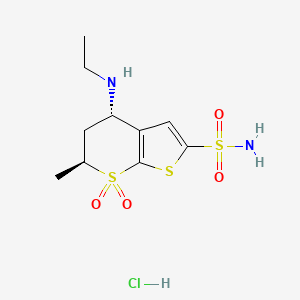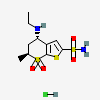Dorzolamide Hydrochloride
- DORZOLAMIDE HYDROCHLORIDE
- 130693-82-2
- Dorzolamide HCl
- Dorzolomide hydrochloride
- Trusopt
- Create:2006-07-28
- Modify:2024-12-28
 Dorzolamide (has active moiety); Dorzolamide Hydrochloride; Timolol Maleate (component of).
Dorzolamide (has active moiety); Dorzolamide Hydrochloride; Timolol Maleate (component of).
- 4-ethylamino-5,6-dihydro-6-methyl-7,7-dioxide-4H-thieno(2,3-b)thiopyran-2-sulfonamide
- 5,6-dihydro-4-ethylamino-6-methyl-4H-thieno(2,3-b)thiopyran-2-sulfonamide-7,7-dioxide
- dorzolamide
- Dorzolamide Chibret
- dorzolamide hydrochloride
- dorzolamide, (trans)-isomer
- L 671152
- L-671,152
- MK 507
- MK-507
- Trusopt
- DORZOLAMIDE HYDROCHLORIDE
- 130693-82-2
- Dorzolamide HCl
- Dorzolomide hydrochloride
- Trusopt
- Cosopt
- Dorzolamide (hydrochloride)
- MK-507
- UNII-QZO5366EW7
- Dorzolamide (as hydrochloride)
- QZO5366EW7
- (4S,6S)-4-(ethylamino)-6-methyl-5,6-dihydro-4H-thieno[2,3-b]thiopyran-2-sulfonamide 7,7-dioxide hydrochloride
- DTXSID1045530
- MK 0507
- MK-0507
- CHEBI:4703
- DTXCID9025530
- Dorzolamide hydrochloride [USAN:USP]
- Trusopt (TN)
- DORZOLAMIDE HYDROCHLORIDE, TRANS-(-)-
- COSOPT COMPONENT DORZOLAMIDE HYDROCHLORIDE
- (4S,6S)-4-(Ethylamino)-5,6-dihydro-6-methyl-4H-thieno(2,3-b)thiopyran-2-sulfonamide 7,7-dioxide, monohydrochloride
- 4H-Thieno(2,3-b)thiopyran-2-sulfonamide, 4-(ethylamino)-5,6-dihydro-6-methyl-, 7,7-dioxide, monohydrochloride, (4S-trans)-
- rac-trans Dorzolamide hydrochloride
- Dorzolamide hydrochloride (USAN:USP)
- DORZOLAMIDE HYDROCHLORIDE (MART.)
- DORZOLAMIDE HYDROCHLORIDE [MART.]
- (4S,6S)-4-(ethylamino)-6-methyl-7,7-dioxo-5,6-dihydro-4H-thieno[2,3-b]thiopyran-2-sulfonamide;hydrochloride
- 4H-Thieno(2,3-b)thiopyran-2-sulfonamide, 5,6-dihydro-4-(ethylamino)-6-methyl-, 7,7-dioxide, monohydrochloride, (4S,6S)-
- DORZOLAMIDE HYDROCHLORIDE (USP-RS)
- DORZOLAMIDE HYDROCHLORIDE [USP-RS]
- DORZOLAMIDE HYDROCHLORIDE (USP IMPURITY)
- DORZOLAMIDE HYDROCHLORIDE [USP IMPURITY]
- DORZOLAMIDE HYDROCHLORIDE (USP MONOGRAPH)
- DORZOLAMIDE HYDROCHLORIDE [USP MONOGRAPH]
- SR-05000001449
- Dorzolamide PF
- Dorzolamide HCI
- Dorzolamide hydrochloride [USAN]
- (4R,6R)-rel-4-(Ethylamino)-5,6-dihydro-6-methyl-4H-thieno[2,3-b]thiopyran-2-sulfonamide 7,7-Dioxide Monohydrochloride; trans-4-(Ethylamino)-5,6-dihydro-6- methyl-4H-thieno[2,3-b]thiopyran-2-sulfonamide 7,7-Dioxide Monohydrochloride;
- (4S,6S)-4-(Ethylamino)-5,6-dihydro-6-methyl-4H-thieno[2,3-b]thiopyran-2-sulfonamide 7,7-dioxide, monohydrochloride
- (4S,6S)-4-(ethylamino)-6-methyl-5,6-dihydro-4H-thieno(2,3-b)thiopyran-2-sulfonamide 7,7-dioxide hydrochloride
- L 671152
- L671152;MK507
- L-671,152
- L671152 hydrochloride;MK507 hydrochloride
- (4S,6S)-4-(ethylamino)-5,6-dihydro-6-methyl-4HH-thieno(2,3-b)thiopyran-2-sulfonamide 7,7-dioxide monohydrochloride
- (4S,trans)-4-(ethylamino)-6-methyl-5,6-dihydro-4H-thieno(2,3-b)thiopyran-2-sulfonamide 7,7-dioxide hydrochloride
- (SS,6S)-N-ethyl-6-methyl-2-sulfamoyl-5,6-dihydro-4H-thieno(2,3-b)thiopyran-4-aminium 7,7-dioxide chloride
- NCGC00016977-01
- CAS-130693-82-2
- SCHEMBL41152
- MLS002154162
- HY-B0109AR
- CHEMBL1201162
- Dorzolamide hydrochloride- Bio-X
- HY-B0109A
- HMS1571O14
- 120279-36-9
- Dorzolamide Hydrochloride Ophthalmic
- EX-A3987
- Tox21_110720
- MFCD00884659
- s1375
- DORZOLAMIDE HYDROCHLORIDE [MI]
- AKOS005146235
- AKOS015895951
- Dorzolamide hydrochloride (JP18/USP)
- Tox21_110720_1
- AC-5244
- CCG-221116
- CS-1858
- Dorzolamide (hydrochloride) (Standard)
- DORZOLAMIDE HYDROCHLORIDE [JAN]
- KS-1348
- DORZOLAMIDE HYDROCHLORIDE [VANDF]
- NCGC00179244-03
- BD164381
- DORZOLAMIDE HYDROCHLORIDE [WHO-DD]
- SMR001233461
- D4189
- C72221
- D00653
- DORZOLAMIDE HYDROCHLORIDE [ORANGE BOOK]
- EN300-19768601
- DORZOLAMIDE HYDROCHLORIDE COMPONENT OF COSOPT
- L-671152
- SR-05000001449-3
- Q27106441
- Z2756516872
- Dorzolamide hydrochloride, European Pharmacopoeia (EP) Reference Standard
- Dorzolamide for system suitability, European Pharmacopoeia (EP) Reference Standard
- Dorzolamide hydrochloride, United States Pharmacopeia (USP) Reference Standard
- (2S,4S)-4-(ethylamino)-2-methyl-1,1-dioxo-2H,3H,4H-1lambda6-thieno[2,3-b]thiopyran-6-sulfonamide hydrochloride
- (4S,6S)-4-(ethylamino)-5,6-dihydro-6-methyl-, 7,7-dioxide 4H-Thieno[2,3-b]thiopyran-2-sulfonamide hydrochloride
- (4S,6S)-4-Ethylamino-6-methyl-5,6-dihydro-4H-thieno(2,3-b)thiopyran-2-sulfonamide 7,7-dioxide monohydrochloride
Dorzolamide (has active moiety)
- Dorzolamide Hydrochloride; Timolol Maleate (component of)


H302 (100%): Harmful if swallowed [Warning Acute toxicity, oral]
H373 (92%): May causes damage to organs through prolonged or repeated exposure [Warning Specific target organ toxicity, repeated exposure]
P260, P264, P270, P301+P317, P319, P330, and P501
(The corresponding statement to each P-code can be found at the GHS Classification page.)
Aggregated GHS information provided per 125 reports by companies from 6 notifications to the ECHA C&L Inventory. Each notification may be associated with multiple companies.
Information may vary between notifications depending on impurities, additives, and other factors. The percentage value in parenthesis indicates the notified classification ratio from companies that provide hazard codes. Only hazard codes with percentage values above 10% are shown.
Acute Tox. 4 (100%)
STOT RE 2 (92%)
Patents are available for this chemical structure:
https://patentscope.wipo.int/search/en/result.jsf?inchikey=OSRUSFPMRGDLAG-QMGYSKNISA-N
- CAS Common ChemistryLICENSEThe data from CAS Common Chemistry is provided under a CC-BY-NC 4.0 license, unless otherwise stated.https://creativecommons.org/licenses/by-nc/4.0/Dorzolamide hydrochloridehttps://commonchemistry.cas.org/detail?cas_rn=130693-82-2
- ChemIDplusDorzolamide hydrochloride [USAN:USP]https://pubchem.ncbi.nlm.nih.gov/substance/?source=chemidplus&sourceid=0130693822ChemIDplus Chemical Information Classificationhttps://pubchem.ncbi.nlm.nih.gov/source/ChemIDplus
- EPA DSSToxDorzolamide hydrochloridehttps://comptox.epa.gov/dashboard/DTXSID1045530CompTox Chemicals Dashboard Chemical Listshttps://comptox.epa.gov/dashboard/chemical-lists/
- European Chemicals Agency (ECHA)LICENSEUse of the information, documents and data from the ECHA website is subject to the terms and conditions of this Legal Notice, and subject to other binding limitations provided for under applicable law, the information, documents and data made available on the ECHA website may be reproduced, distributed and/or used, totally or in part, for non-commercial purposes provided that ECHA is acknowledged as the source: "Source: European Chemicals Agency, http://echa.europa.eu/". Such acknowledgement must be included in each copy of the material. ECHA permits and encourages organisations and individuals to create links to the ECHA website under the following cumulative conditions: Links can only be made to webpages that provide a link to the Legal Notice page.https://echa.europa.eu/web/guest/legal-notice(2s,4s)-2-ethylamino-4-methyl-5,5-dioxo-5,7-dithiabicyclo[4.3.0]nona-8,10-diene-8-sulfonamide hydrochloridehttps://echa.europa.eu/substance-information/-/substanceinfo/100.149.022(2s,4s)-2-ethylamino-4-methyl-5,5-dioxo-5,7-dithiabicyclo[4.3.0]nona-8,10-diene-8-sulfonamide hydrochloride (EC: 620-304-2)https://echa.europa.eu/information-on-chemicals/cl-inventory-database/-/discli/details/153130
- FDA Global Substance Registration System (GSRS)LICENSEUnless otherwise noted, the contents of the FDA website (www.fda.gov), both text and graphics, are not copyrighted. They are in the public domain and may be republished, reprinted and otherwise used freely by anyone without the need to obtain permission from FDA. Credit to the U.S. Food and Drug Administration as the source is appreciated but not required.https://www.fda.gov/about-fda/about-website/website-policies#linkingDORZOLAMIDE HYDROCHLORIDEhttps://gsrs.ncats.nih.gov/ginas/app/beta/substances/QZO5366EW7
- ChEMBLLICENSEAccess to the web interface of ChEMBL is made under the EBI's Terms of Use (http://www.ebi.ac.uk/Information/termsofuse.html). The ChEMBL data is made available on a Creative Commons Attribution-Share Alike 3.0 Unported License (http://creativecommons.org/licenses/by-sa/3.0/).http://www.ebi.ac.uk/Information/termsofuse.html
- Comparative Toxicogenomics Database (CTD)LICENSEIt is to be used only for research and educational purposes. Any reproduction or use for commercial purpose is prohibited without the prior express written permission of NC State University.http://ctdbase.org/about/legal.jsp
- Drug Gene Interaction database (DGIdb)LICENSEThe data used in DGIdb is all open access and where possible made available as raw data dumps in the downloads section.http://www.dgidb.org/downloadsDORZOLAMIDE HYDROCHLORIDEhttps://www.dgidb.org/drugs/rxcui:236065
- ClinicalTrials.govLICENSEThe ClinicalTrials.gov data carry an international copyright outside the United States and its Territories or Possessions. Some ClinicalTrials.gov data may be subject to the copyright of third parties; you should consult these entities for any additional terms of use.https://clinicaltrials.gov/ct2/about-site/terms-conditions#Use
- Open TargetsLICENSEDatasets generated by the Open Targets Platform are freely available for download.https://platform-docs.opentargets.org/licenceDORZOLAMIDE HYDROCHLORIDEhttps://platform.opentargets.org/drug/CHEMBL1201162
- DailyMedDORZOLAMIDE HYDROCHLORIDEhttps://dailymed.nlm.nih.gov/dailymed/search.cfm?labeltype=all&query=DORZOLAMIDE+HYDROCHLORIDE
- Drugs@FDALICENSEUnless otherwise noted, the contents of the FDA website (www.fda.gov), both text and graphics, are not copyrighted. They are in the public domain and may be republished, reprinted and otherwise used freely by anyone without the need to obtain permission from FDA. Credit to the U.S. Food and Drug Administration as the source is appreciated but not required.https://www.fda.gov/about-fda/about-website/website-policies#linkingDORZOLAMIDE HYDROCHLORIDEhttps://www.accessdata.fda.gov/scripts/cder/daf/
- EU Clinical Trials Register
- FDA Orange BookLICENSEUnless otherwise noted, the contents of the FDA website (www.fda.gov), both text and graphics, are not copyrighted. They are in the public domain and may be republished, reprinted and otherwise used freely by anyone without the need to obtain permission from FDA. Credit to the U.S. Food and Drug Administration as the source is appreciated but not required.https://www.fda.gov/about-fda/about-website/website-policies#linking
- KEGGLICENSEAcademic users may freely use the KEGG website. Non-academic use of KEGG generally requires a commercial licensehttps://www.kegg.jp/kegg/legal.htmlTherapeutic category of drugs in Japanhttp://www.genome.jp/kegg-bin/get_htext?br08301.kegUSP drug classificationhttp://www.genome.jp/kegg-bin/get_htext?br08302.kegAnatomical Therapeutic Chemical (ATC) classificationhttp://www.genome.jp/kegg-bin/get_htext?br08303.kegTarget-based classification of drugshttp://www.genome.jp/kegg-bin/get_htext?br08310.kegDrugs listed in the Japanese Pharmacopoeiahttp://www.genome.jp/kegg-bin/get_htext?br08311.keg
- National Drug Code (NDC) DirectoryLICENSEUnless otherwise noted, the contents of the FDA website (www.fda.gov), both text and graphics, are not copyrighted. They are in the public domain and may be republished, reprinted and otherwise used freely by anyone without the need to obtain permission from FDA. Credit to the U.S. Food and Drug Administration as the source is appreciated but not required.https://www.fda.gov/about-fda/about-website/website-policies#linkingDORZOLAMIDE HYDROCHLORIDEhttps://www.fda.gov/drugs/drug-approvals-and-databases/national-drug-code-directory
- NCI Thesaurus (NCIt)LICENSEUnless otherwise indicated, all text within NCI products is free of copyright and may be reused without our permission. Credit the National Cancer Institute as the source.https://www.cancer.gov/policies/copyright-reuseNCI Thesaurushttps://ncit.nci.nih.gov
- NIPH Clinical Trials Search of Japan
- NLM RxNorm TerminologyLICENSEThe RxNorm Terminology is created by the National Library of Medicine (NLM) and is in the public domain and may be republished, reprinted and otherwise used freely by anyone without the need to obtain permission from NLM. Credit to the U.S. National Library of Medicine as the source is appreciated but not required. The full RxNorm dataset requires a free license.https://www.nlm.nih.gov/research/umls/rxnorm/docs/termsofservice.htmldorzolamide hydrochloridehttps://rxnav.nlm.nih.gov/id/rxnorm/236065
- Springer Nature
- Wikidatadorzolamide hydrochloridehttps://www.wikidata.org/wiki/Q27106441
- PubChem
- Medical Subject Headings (MeSH)LICENSEWorks produced by the U.S. government are not subject to copyright protection in the United States. Any such works found on National Library of Medicine (NLM) Web sites may be freely used or reproduced without permission in the U.S.https://www.nlm.nih.gov/copyright.htmldorzolamidehttps://www.ncbi.nlm.nih.gov/mesh/67062765Antihypertensive Agentshttps://www.ncbi.nlm.nih.gov/mesh/68000959Carbonic Anhydrase Inhibitorshttps://www.ncbi.nlm.nih.gov/mesh/68002257
- GHS Classification (UNECE)GHS Classification Treehttp://www.unece.org/trans/danger/publi/ghs/ghs_welcome_e.html
- MolGenieMolGenie Organic Chemistry Ontologyhttps://github.com/MolGenie/ontology/
- PATENTSCOPE (WIPO)SID 389158381https://pubchem.ncbi.nlm.nih.gov/substance/389158381


 CID 313 (Hydrochloric Acid)
CID 313 (Hydrochloric Acid)